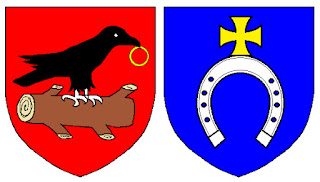[Achievement
– the name given in heraldry to the full pictorial representation of a coat of
arms.]
Earlier this year scientists solved a decades-old mystery
surrounding the remains of a Polish general who fought in the American War of
Independence. They declared that the general, Casimir Pulaski (1745-1779), was intersex.
The story behind this mystery is itself worthy of a separate article for the
future, but for today let’s celebrate by looking at his coat of arms (below).
Casimir (or Kazimierz in his native Polish) was born during
the time of the Polish-Lithuanian Commonwealth. He was a leading commander in a
failed rebellion against Russian domination and was stripped of all his
military honours. He escaped to France and then to America. Today is the anniversary
of Pulaski’s death.
Polish heraldry differs from that of nations like the UK in
that there was never any official state authority to regulate its use. It
wasn’t until the late 20th century that Polish historians began to collect the
many Polish coats of arms illustrated in various sources into one authoritative
collection. Until then Polish heraldry was illustrated in family and local
documents and non-Polish publications. Consequently, the coat of arms of one
family could change with each generation.
The Polish feudal system in the Middle Ages also influenced
how heraldry developed. There was more of a clan element to Polish feudalism. The
Pulaski family belongs to a very large clan which includes families currently
having over 900 different family names. Most of these names are based on the
name of the town or village where that branch of the family lived. Going
further back the Pulaski and the other 900 families descend from the Ślepowron
family.
The Ślepowron family took its name from the village of Ślepowrony
and their earliest known ancestor was called Wawrzęta Korwin z Ślepowron. This
reveals the ultimate origin of the clan in the Korwin family. It was Wawrzęta who
was granted the coat of arms (below left) in 1224 by the ruling prince of
Poland. For several centuries there were variations on the design, with the
crow facing the other way and/or standing on a crown instead of a log.
Heraldry has always used puns and visual clues to the
identity of the family or original grantee of the coat of arms. The crow has
been used across Europe as an emblem of unrelated families with similar names.
Its Latin name is “corvus” (still used as the scientific name for the crow
family of birds). Families such as Corvo, Corbett and, yes, even Corbyn, adopted
crows in their coats of arms. Jeremy Corbyn, Leader of the Opposition in the
UK, is descended from a family who had three crows in their coat of arms.
Another member of the lgbt community was descended from Wawrzęta
Korwin z Ślepowron and used his coat of arms. She was the Russian mathematician
Sofia Kovalevskaya (1850-1891). Her full family name was Korvin-Krukovskaya and
also derives from “corvus”.
There’s a medieval family legend telling how the crow the family
their name. They allegedly descent from a Roman general called Marcus Valerus.
The legend says that Valerus confronted a huge barbarian warrior in battle. As
he attacked the warrior a huge crow flew down and pecked the barbarian’s eyes
out. Valerus killed the warrior and from then on he was called Corvus.
Another medieval legend explains why the crow has a gold
ring in its beak. It relates to a king of Hungary called Matthias Corvinus
Hunyadi (1443-1490), a supposed descendant of General Corvus. One day King
Matthias took off his gold ring and put it aside whereupon a crow swooped down
and flew off with it. The king followed the bird, killed it and retrieved his
ring. From then on he put the ring in the beak of the crow on his coat of arms.
In truth King Matthias has no Corvinus/Korwin ancestry, and the Korwins are not
related to him. However, 17th century historians fabricated the connection and
the gold ring was adopted by most of the 900 Ślepowron/Korwin families,
including the Pulaskis.
The crow also appears as the crest on top of the helmet in
most of these Ślepowron/Korwin families. The helmet itself, and the coronet on
top of it, is traditional in the heraldic achievements of Polish non-titled
aristocracy like the Pulaskis.
The Pulaski branch of the Ślepowron/Korwin family later
added a horseshoe to the coat of arms. They also changed the colour of the
shield from red to blue. These changes occurred through the marriage of an
ancestor to an heiress in the Pobog family. The Pobog family coat of arms
(above right, next to the red coat of arms of Wawrzęta Korwin z Ślepowron and Sofia
Kovalevskaya) contains a horseshoe and cross.


I never said he had a pussy. All I said is that he is now regarded by scientists and historians as being intersex. YOU wake up.
ReplyDelete